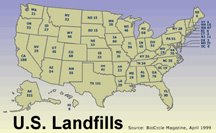War on scrap tires costly but effective
The Columbus Dispatch
COLUMBUS - Since 1998, the state has spent more than $27 million to clean up more than 41 million illegal scrap tires.
While some companies have paid for cleanups, many leave the tab for the Ohio Environmental Protection Agency. In nine years, the agency has had to do a lot of the work itself and has recouped costs from only one company responsible for piles of tires that threaten the environment and public health.
"Cost recovery is very difficult," said Chris Newman, scrap-tire program coordinator for Region 5 of the U.S. EPA. "It is something a lot of states have wrangled with."
Despite the expense, industry leaders and environmental experts praise Ohio's scrap-tire program as one of the best in the nation.
Ohio's program is funded by a $1 fee on all new tires sold in the state. The program, which was started in 1998 when the fee was 50 cents, raises about $7 million annually.
Bob Large, who supervises the Ohio EPA's scrap-tire program, said that fewer than 4 million scrap tires are left to clean up and recycle in Ohio, at a cost of about $1 a tire.
The program has worked so well, experts say, that the state can focus on smaller tire dumps.
One of them is at 37 Auto Parts, a motor salvage business in Bremen, east of Lancaster in Fairfield County.
In May, EPA officials asked the junkyard to remove about 7,000 scrap tires.
Sherman Moss, who was hired for the job, said it would likely cost about $12,000 and take until mid-September.
In 2005 and '06, dump owners paid for 54 cleanups, the EPA said. In all, they removed 2.6 million tires.
Large said not all owners take that route, leaving the cleanup and the cost to the state.
"Most don't have financial resources to do it themselves," he said.
And they often don't have the money to pay the state afterward, either. Large said the state paid to clean up 45 sites.
One company has repaid the state, but only a fraction of the cost.
That 2005 cleanup at a dump in Scioto County cost $493,000; the owners paid the state $45,000.
"They're not rich people," Newman said of dump owners.
In hopes of recouping some money, the Ohio EPA has so far sent 10 cases seeking $23 million to the state attorney general. More cases are in the pipeline.
Large said scrap-tire polluters often claim bankruptcy, allowing them to avoid reimbursing the state.
In some cases, the state places a lien on their property.
The Rubber Manufacturers Association said 188 million scrap tires lay in dumps nationwide in 2005, down from an estimated 1 billion in 1990.
Most tires have been recycled and turned into everything from landfill liners and mud flaps to rubberized mulch and radiator hoses.
Although tire-removal programs cost state governments, tire-industry leaders say they're needed.
In 1999, 4 million tires at Ohio's largest stockpile, Kirby Tire Recycling in Wyandot County, burned for six days. The site had 19 million tires in all.
Rain washed oily pollutants into the Sandusky River and Sycamore Creek, where the toxins killed more than 10,000 fish.
Large said he hoped to finish cleaning that dump by this Thanksgiving. So far, the state has spent about $13.9 million there.
In addition to pollution problems, scrap tires are health hazards, the EPA says.
In 1999, a 13-year-old boy from Fairfield County died of mosquito-borne encephalitis that health officials said likely stemmed from a dump with more than 740,000 tires.
"There are many things that can happen to a pile of tires," said Michael Blumenthal, senior technical director of the Rubber Manufacturers Association. "None of them are good."
Fairfield County workers and student volunteers removed the tires. The county paid for the cleanup.













